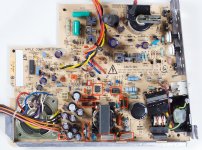hey, this is my first post to the forum.
A couple of days ago I bought a lot of old computers in which came 4 Macintosh classics, not a single one turned on.
I chose to start working in one of the 220v models as it is the voltage that my country has.
After researching a bit on reddit, this forum and such, i came to the conclussion that the Analog board needed to be recapped.
after recapping the a/b now the computer turned on, but the screen wobbled a lot and showed a checkerboard pattern, after researching a bit more, I washed the logic board, then tried again, same thing.
i took out the logic boards from all 4 macs, washed them, tried them, same thing.
then i came across a post on this forum about measuring the voltages at the floppy port.
i got 11.2v and 4.2v in the floppy connector, with that known, I researched a bit more and then replaced optoisolator, dp3, dp4 and IRFBC40.
now the computer is showing the exact same problems that the user 6502 has made a post about, after two minutes of being turned on, the computer suddenly boots, the screen stops shaking, and it boots from the hard drive.
im stumped as what it could be as the reported solution to that problem is replacing the optoisolator, dp3 and 4.
sorry for the bad formating and English. English is not my native language.
A couple of days ago I bought a lot of old computers in which came 4 Macintosh classics, not a single one turned on.
I chose to start working in one of the 220v models as it is the voltage that my country has.
After researching a bit on reddit, this forum and such, i came to the conclussion that the Analog board needed to be recapped.
after recapping the a/b now the computer turned on, but the screen wobbled a lot and showed a checkerboard pattern, after researching a bit more, I washed the logic board, then tried again, same thing.
i took out the logic boards from all 4 macs, washed them, tried them, same thing.
then i came across a post on this forum about measuring the voltages at the floppy port.
i got 11.2v and 4.2v in the floppy connector, with that known, I researched a bit more and then replaced optoisolator, dp3, dp4 and IRFBC40.
now the computer is showing the exact same problems that the user 6502 has made a post about, after two minutes of being turned on, the computer suddenly boots, the screen stops shaking, and it boots from the hard drive.
im stumped as what it could be as the reported solution to that problem is replacing the optoisolator, dp3 and 4.
sorry for the bad formating and English. English is not my native language.

